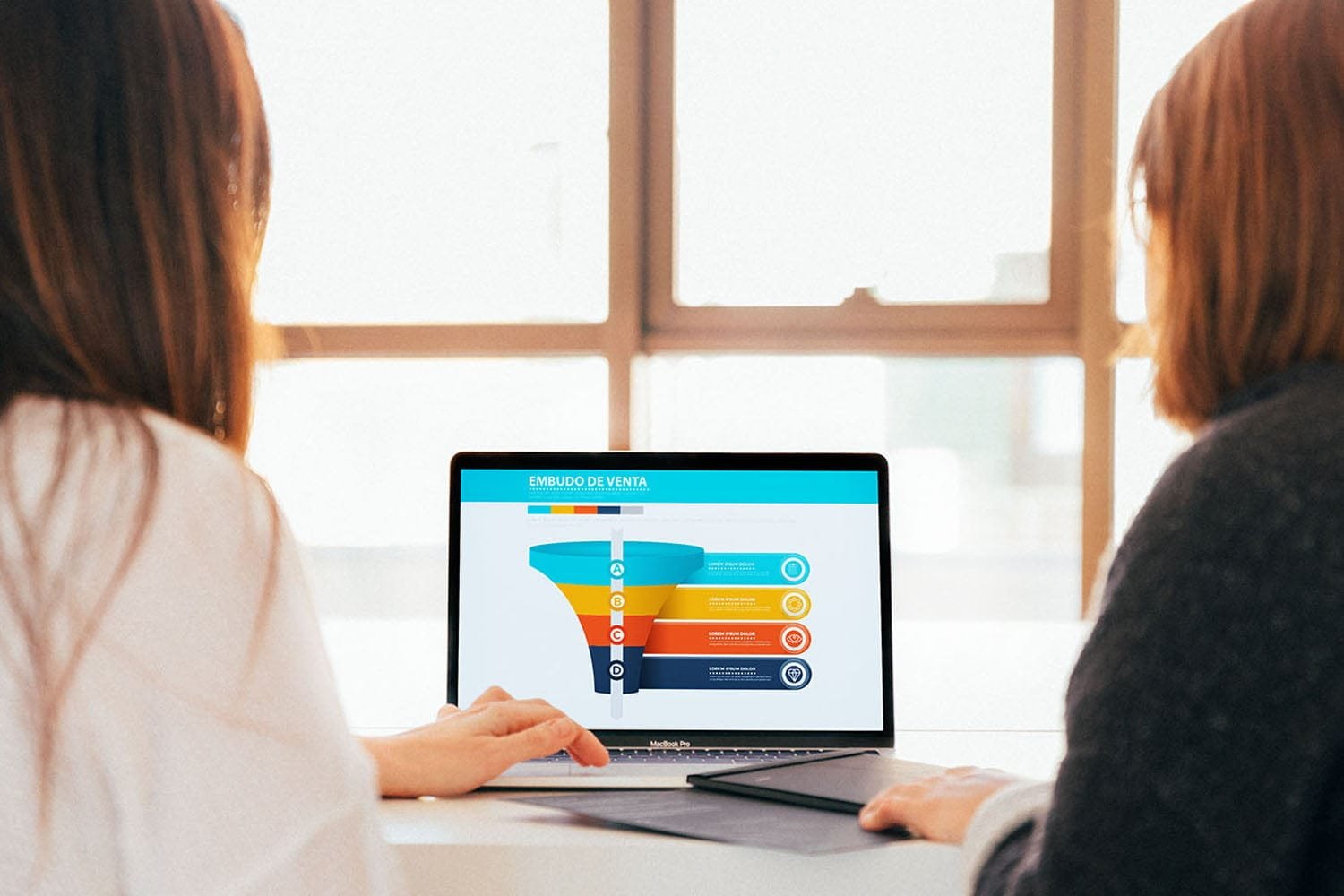Si quieres conseguir leads y lograr su conversión en clientes reales, los embudos de ventas, embudo de conversión o funnels son la mejor herramienta que puedes implementar en tu empresa.
If you want to get leads and convert them into real customers, sales funnels, conversion funnels or funnels are the best tool you can implement in your company.
What is a sales funnel?
We probably have a specific objective that we want to achieve. The conversion funnel seeks to take the user through a series of steps until they reach our goal. Normally the final goal is to buy a product or service, but to get there the customer goes through a process. Let’s see how we can optimize each of these phases to convert our potential customers into real customers.
This is achieved by having a framework or work scheme that allows us to have a global vision (big picture) of the sales process of our web visitors.


Utility of the funnel: why use a sales funnel?
A visitor who enters our website is a business opportunity. Every day we receive users on our website, therefore, every day business opportunities (or information) come in that need to be organized.
- Improve your users experience. Reduce the phases that the lead (potential customer) has to go through to become a real customer. This will make them more satisfied and the process will be faster.
- Detect users who are really interested in your product or service to offer them personalized offers and discounts.
- Optimize your investment in the communication tools you use (Content Marketing, Public Relations, Email Marketing…).
- Get to know your customers better. Adapt to their needs and improve your relationship with them in order to retain loyal customers.
- Detect at what stage users abandon the funnel. For example, most users abandon the landing page when they are asked to fill out a form.
- Based on the above, detect your mistakes and where you can improve.
- Concentrate your efforts on those stages that are most important (that generate the most leads).
- Calculate the ROI of your campaign.
Steps to create your funnel
La clave del embudo de conversión es que empujes a tus clientes interesados o leads a la siguiente fase, hasta llegar al final del proceso. Para ello, tienes que conocer las herramientas adecuadas que debes usar en cada una de las etapas.
The key to the conversion funnel is to push your interested customers or leads to the next stage, until you reach the end of the process. To do this, you need to know the right tools to use at each stage.
1. Acquisition
First of all, we are going to implement our online marketing strategy to attract as many visitors as possible to our website (mass marketing).
Useful tools:
- Google Ads.
- Social Ads (Facebook Ads e Instagram Ads).
- Landing pages.
- SEO.
2. Interest or activation
As a result of the previous section, we will have awakened the interest of the users, generating confidence in them, so that they will move on to the next phase.
Useful tools:
- Píxel de Facebook.
- Mail Marketing.
- Google Analytics.
- Contenidos – Inbound (vídeos, podcasts…).
3. Decision
The objective of this stage is to convert users into registrations or leads, trying to get them to spend as much time as possible on our site.
Useful tools:
- CRMs System.
- Automated email campaigns.
- Content such as frequently asked questions, videos, reviews, etc.…
4. For sale
That is, conversion. Potential customers become real customers.
Useful tools:
- Remarketing actions.
- Follow-up with emails or calls.
- Abandoned cart tracking.
5. Reference
Finally, with this after-sales phase, we ensure that users are satisfied so that they repeat the purchase and recommend us.
Useful tools:
- Online after-sales surveys.
- Personalized offers and discounts.
What to do before creating a sales funnel
Surely you want to create the conversion funnel for your business, but first I advise you to analyze a number of aspects.
Who is your audience and what is your current sales process like?
Analyze how your current customers behave (which pages generate the most traffic on your website, how long they spend on your site, when they abandon your page…). Recommended tool: Google Analytics.
In other words, think about how your current sales funnel is structured, what the sales process looks like from the time you engage customers in the acquisition process until conversion occurs.
What strategy will you use to generate leads?
Take a look at your marketing plan, what strategies you have implemented and which ones work best for you. Increase your efforts in the latter and include them in your sales funnel.
Possible platforms to create funnels: Google Ads, Facebook and Instagram Ads, YouTube Ads, Twitter Ads, LinkedIn Ads…
Recommended strategies: SEO and inbound content.
Essential for the success of the sales funnel: the landing page
The landing page is the one that is specially designed to convert your visitors into leads. In other words, the objective of the landing page is to capture as many interested customers as possible, not to close sales. Important: don’t forget to include a powerful call-to-action.
Keep your leads flowing with Mail Marketing
Create campaigns from time to time with relevant content to remind them that you are there. You can include offers in the email that will push them to convert. Most importantly, keep in mind that they are at a stage where they are hesitant to make a purchase decision.
Create an outline of the sales process
Design the conversion funnel, the stages you want customers to go through. Here is an example:
Customer not contacted > Interested customer (lead) > Customer contacted > Proposal > Negotiation > Sale closed
Create your sales funnel in Google Analytics in 3 easy steps
Step 1
Assuming you already have an active Google Analytics account, go to “Administrator” – “Goals” – “Create new goal“. After that, Google will give you a number of default options, although you can also choose the goal you want to achieve yourself. If you don’t have a Google Analytics account yet and you want to learn how to use this tool, I recommend you to read this post on How to use Google Analytics to analyze your results
Step 2
After filling in the description of the objective, you will see a section that says “Conversion funnel“. Select “yes”.
Define the order you want users to follow until they reach your Target URL. The sales funnel is now created.
Paso 3
Analyze if your goals are being met. From the main Google Analytics dashboard, follow the steps below:
“Conversions” – “Goals” – “Conversion funnel chart”.
If you have come this far, I recommend that you use other tools that allow you to optimize your sales funnel. For example, a software to analyze the stages of the funnel. You can choose between these options: HubSpot, ClickFunnels, or Active Campaign.


